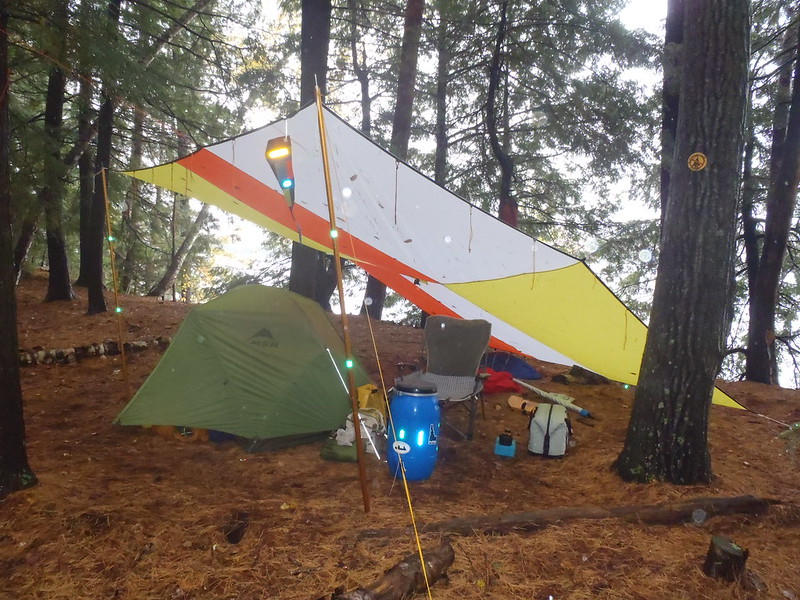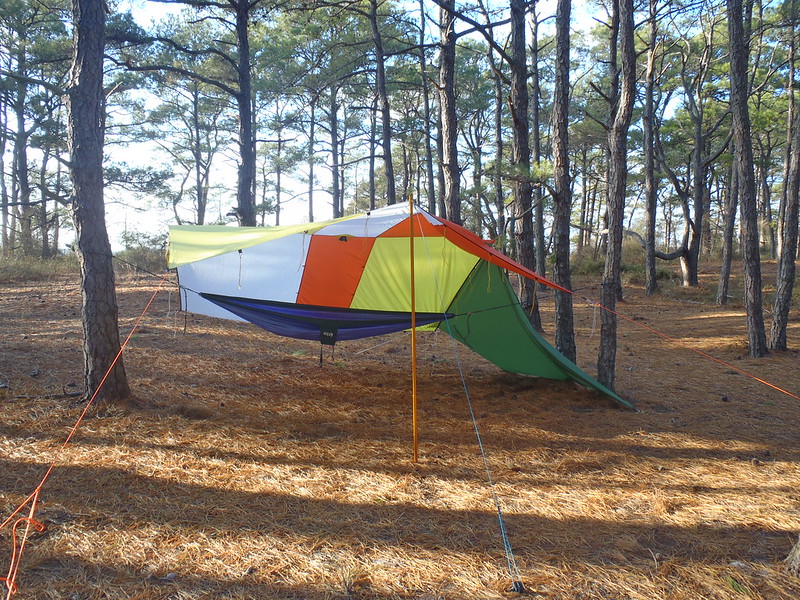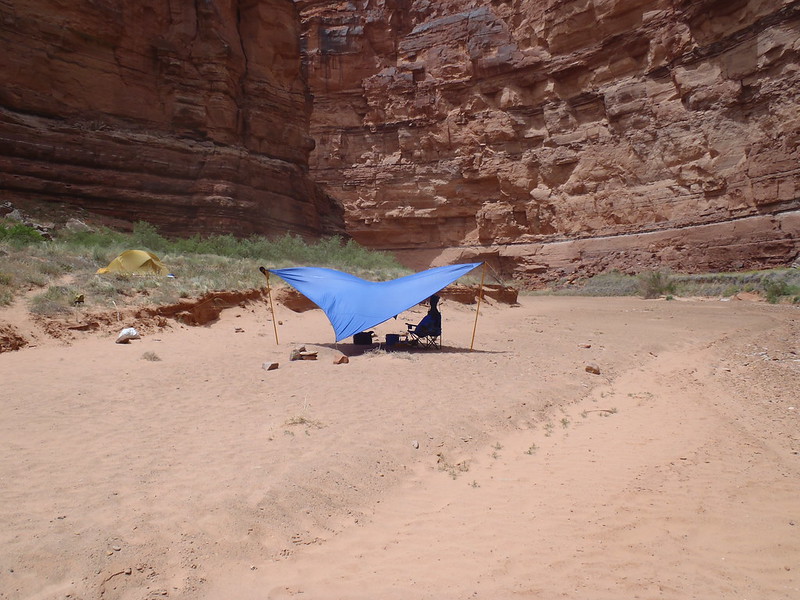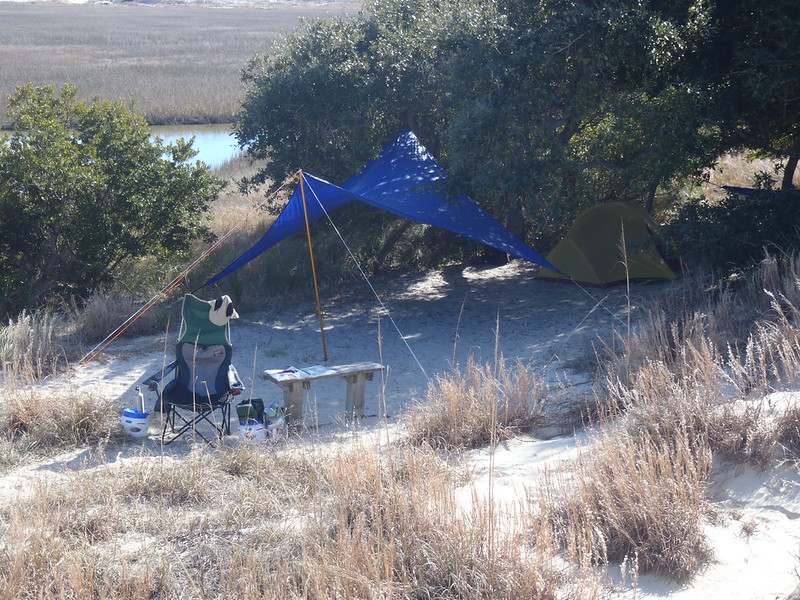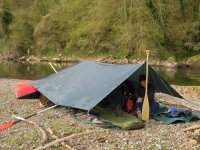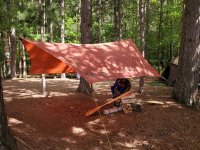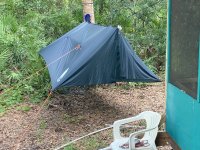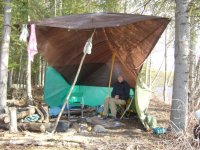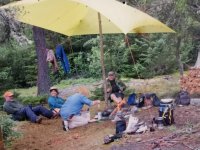About the weirdo “Don’t step on the river bottom” business; a few sections of river in Virginia (and maybe elsewhere?) are subject to landowner’s claims of still existent “Kings Grant” rights, including ownership of the river bottom. Lots of litigation about that in Virginia.
Ah, tarps. I love me some tarps, different tarps for different solo or group sizes and different environments and applications.
In areas with a dearth of trees most tarps can be set up using two poles. I’m partial to adjustable height Kelty tarp poles. Durable and dependable, if there is only one suitable tree on which to attach a ridgeline a single pole on the other side works fine.
https://www.campmor.com/products/ke...Zxd3CPJF8DvVb86PNBwtrtBqIdISmW9hoCSM4QAvD_BwE
Using a just two poles gets trickier in setting a ridge line, easiest done using two angled guy lines off the pole(s) and, because you can’t hold both poles upright at once, there are some tricks to doing that by yourself.
Easiest way, for me, is to measure off* the tarp orientation and spacing, and stake out two angled guylines from a tilted-back-a-bit pole, then, still holding the pole, add a third, temporary guy line, facing inwards and stake it down inside the tarp area to form a tripod of taut-ish lines holding that pole upright.
Attach the ridgeline to that now steadied pole, walk it back keeping a little (tricky part) tension on it, and anchor the other two guy lines as usual outside the tarp area. Then walk back and unstake the third leg of the tripod from under the tarp area; since it is already attached and has a stake I usually just add it to that side, with three guylines /|\. Then adjust the pole heights and guy line tension as needed. Height adjustable poles are really handy in that guise.
That sounds more difficult than it is. Probably took longer to describe than to do once you have some practice.
Two or even three guy lines off a pole tip have other advantages. The blue wing in the canyon has three guy lines off each corner, attached to deadmen buried in the sand. With piles of rock atop. It was seriously freaking windy, for days.
*OK, I “cheat” at measuring tarp spacing. I have a length of cord in the stake bag with long pushpin attached at one end, and a knot in the cord at the minimum distance between trees for a 10’ ridgeline and for a 14’ ridgeline. The tarp is almost always at the 10’ orientation, so I have more wind wall to drop for blowing rain, and my day hammock fits better with trees 12 to 14 feet apart. I just push pin one end to a tree and step off in different directions.
That string measuring device is handy when there are too many tree options. “These two are too close, and these two are too far apart, and these two are juuuuust right”. With ample choices of trees like an open piney forest the anticipated wind direction and being able to drop one side or the other becomes a factor.
At times, even when there are two well spaced trees I’ll use a pole somewhere on the tarp edge to create better directed drainage for shedding rain. I try to be cognizant of where rain will drain off a tarp, and where it will run or pool on the ground; I’d rather direct it away from flowing puddles-underfoot back under the tarp, and away from my tent if proximity need be.
That is both how the tarp is erected and some visual “
Which way will it flow?” ground surveillance. I can’t say I always get it right, but I’m getting better with practice.
Quality tarp poles, or even a single pole, help. There are one (or two) Kelty poles in different tarp applications in all of the photos, some just for better drainage purposes.
I know some folks use their paddles as poles, including using two paddles connected with a sleeve. I’ve never been fond of that solution. I don’t want my paddles unavailable holding up the tarp if I opt to day paddle from camp, and don’t want one end of any of our paddles being ground into the dirt or duff.
And, with a parawing, arching concave downwards in the middle, the poles need to be adjusted taller than with a flat tarp. With fully extended 99” Kelty poles that 8 ¼ foot height puts the center of a wing a bit of 6 feet high. Get ready to crouch and shuffle around the edges.
Another caution about “wing” tarps, and I do love a real wing tarp for high winds. A lot (maybe most) of wing tarps I’ve seen are not actually parawings. They are shaped <> , and do have a concave arch profile along the top, but do not actually have the catenary shape that makes a true wing. In the photo of the wing in the windy canyon the lofted “bat wing” curves are obvious.
That true wing shape acts much like an airplane wing; the catenary cuts lift the wing in higher winds instead of depressing it, forming that shape. The harder it blows the “stiffer” the wing becomes. If erected properly a wing doesn’t flap or billow, and even in very high winds the fabric and stitching, held rock steady, seem to be under far less stress.
The other facet of a wing is most useful on desert or coastal trips. Rainwater flows predictably off just the low corners. I tie a little string there, to prevent the rain from shooting off the side past the bucket. A collapsible bucket set at the corner makes a handy freshwater collector. Note the collapsible bucket under the far corner of the wing, and a couple other filled buckets set off to the side.
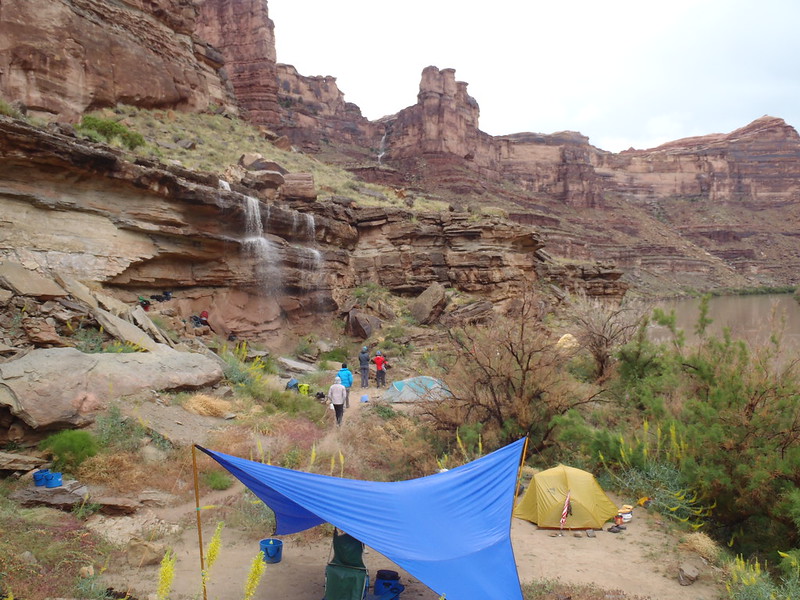 P5112025
P5112025 by
Mike McCrea, on Flickr
The river is silt-brown as usual, and the water pouring over the rock face is filled with dirt, sand and god only knows what critter crap or carcass bits from the top of the plateau. The rainwater that comes off the wing is often dang near crystal clear. During a sleet storm on a desert trip I had a bucket of ice water. And some beers that needed chilling. Score one for the wing.
We own a different “wing”, an early NRS River Wing.
https://www.nrs.com/nrs-river-wing/...U9e60nXb7BWnWm6FmqtR-jQmLCL9DoYxoCfgAQAvD_BwE
It is a wonderful tarp, 17’ x 16’, but our early version does not have a true catenary cut, and is made of much heavier material than the current 4.3lb version specs. I know NRS did a redesign of the River Wing years ago, with lighter weight materials, but it still doesn’t
look like it has true catenary cuts.
Our River Wing was made as a raft trip tarp, and with a couple poles and eight beefy sand stakes it is most suitable for that application, or for car campers and no-portage group trips. Overkill for one or two person trips.
Our (true) blue wing is close to 30 years old, and while it is still going strong someday I will need to replace it. That one, IIRC, is 19’ x 19’; with the true catenary cuts and loss of headroom at the low corners it is ideal for 1 to 3 people, 4 max, otherwise it is standing room only.
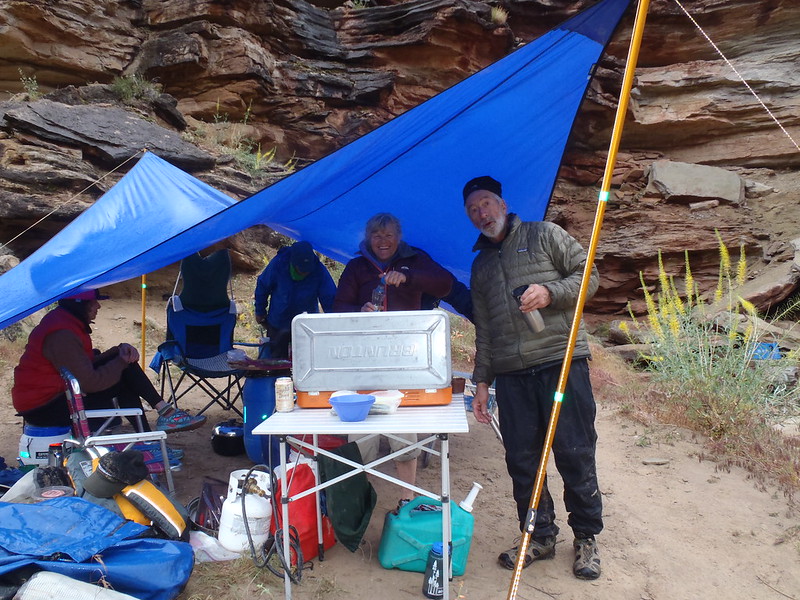 P5112034
P5112034 by
Mike McCrea, on Flickr
If anyone knows of a true wing, with properly designed catenary cuts, that 19x19 size or a little smaller please do tell; I have a friend who lusts after mine, and he’s getting impatient waiting for the reading of my will.
Although I expect, looking at recent prices, that I’ll say YIKES! and stick with what we have. The heavy duty rafter version NRS River Wing as half that $450 price at the time.
If I could only have one tripping tarp to choose from I’d have a rectangular Cooke Custom Sewing Tundra Tarp, in bright cheery multi-colors. Maybe ordered one size larger than I
think I need; a little more tarp is almost always better than one a bit too small.



